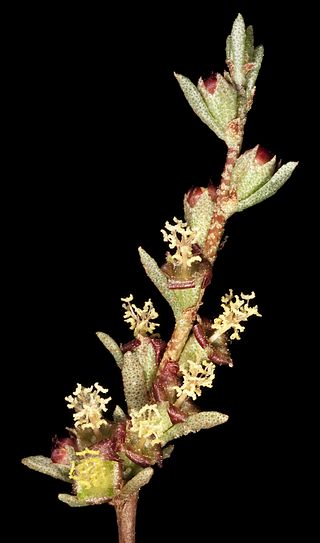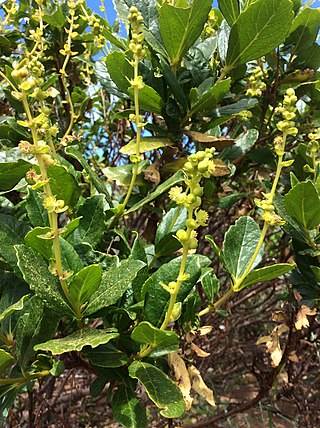
St Leonards is a coastal township near Geelong, Victoria, Australia, at the eastern end of the Bellarine Peninsula and the northern end of Swan Bay. Situated 33 kilometres (21 mi) east of Geelong, St Leonards was a filming location for the Australian television series SeaChange.

The Bellarine Peninsula is a peninsula located south-west of Melbourne in Victoria, Australia, surrounded by Port Phillip, Corio Bay and Bass Strait. The peninsula, together with the Mornington Peninsula, separates Port Phillip Bay from Bass Strait. The peninsula itself was originally occupied by Indigenous Australian clans of the Wathaurong nation, prior to European settlement in the early 19th century. Early European settlements were initially centred on wheat and grain agriculture, before the area became a popular tourist destination with most visitors arriving by paddle steamer on Port Phillip in the late 19th century.

Acacia implexa, commonly known as lightwood or hickory wattle, is a fast-growing Australian tree, the timber of which is used for furniture making. The wood is prized for its finish and strength. The foliage was used to make pulp and dye cloth.

Lake Victoria is a 139-hectare (340-acre) shallow saline lake on the Bellarine Peninsula, Victoria in Australia, close to the township of Point Lonsdale and part of the Lonsdale Lakes Nature Reserve administered by Parks Victoria.

Suaeda australis, the austral seablite, is a species of plant in the family Amaranthaceae, native to Australia. It grows to 10 to 90 cm in height, with a spreading habit and branching occurring from the base. The leaves are up to 40 mm in length and are succulent, linear and flattened. They are light green to purplish-red in colour.

Carpobrotus rossii is a succulent coastal groundcover plant native to southern Australia. It is known by various common names, including karkalla, pig face, sea fig and beach bananas.

Lawrencia is a plant genus in the family Malvaceae. The genus is endemic to Australia.

Adriana quadripartita, the bitter bush, is a shrub in the family Euphorbiaceae. The species, which is endemic to southern Australia, has an erect open habit, growing to between 0.5 and 3 metres or more high.
The Port Phillip Bay and Bellarine Peninsula Ramsar Site is one of the Australian sites listed under the Ramsar Convention as a wetland of international importance. It was designated on 15 December 1982, and is listed as Ramsar Site No.266. Much of the site is also part of either the Swan Bay and Port Phillip Bay Islands Important Bird Area or the Werribee and Avalon Important Bird Area, identified as such by BirdLife International because of their importance for wetland and waterbirds as well as for orange-bellied parrots. It comprises some six disjunct, largely coastal, areas of land, totalling 229 km2, along the western shore of Port Phillip and on the Bellarine Peninsula, in the state of Victoria. Wetland types protected include shallow marine waters, estuaries, freshwater lakes, seasonal swamps, intertidal mudflats and seagrass beds.

Pultenaea tenuifolia, commonly known as slender bush-pea, is a species of flowering plant in the family Fabaceae and is endemic to southern Australia. It is a spreading or low-lying to prostrate and mat-forming shrub with hairy branches, narrow lance-shaped leaves, and yellow to orange and red, pea-like flowers.

Tetragonia implexicoma, commonly known as bower spinach, is a species of plant in the Aizoaceae, or ice-plant family. A similar species is Tetragonia tetragonioides, however this species has larger leaves and a shorter flowering time.
Hemichroa pentandra, commonly known as trailing hemichroa, trailing saltstar or trailing jointweed, is a prostrate perennial herb in the amaranth family. It is endemic to Australia. A succulent halophyte, it grows to about 10 cm in height and 30 cm wide. It has tiny, inconspicuous white flowers, surrounded by papery bracts, which grow in the angle between the stem and the 12 mm long leaves. It is found in coastal salt marshes and around salt lakes.

Actites, commonly known as the dune thistle, beach thistle or coastal sow thistle, is a genus of flowering plants in the family Asteraceae. It is endemic to Australia and contains only one species, Actites megalocarpa. It is a large, clumping herb with yellow flowers.
Swainsona lessertiifolia, commonly known as the coast Swainson-pea, is a sprawling, largely coastal, perennial herb in the pea family that is endemic to south-eastern Australia. It grows to about 50 cm in height, has divided leaves and bears sprays of rich purple pea flowers. It is found in coastal dune communities.

Austrostipa stipoides, commonly known as prickly spear-grass or coast spear-grass, is a kind of tussock grass native to the coasts of south-eastern Australia and of New Zealand. It forms large clumps up to about 80 cm in height with smooth inrolled leaves 70 cm long and 1 mm wide with sharp tips. It is found on sea cliffs, the edges of beach dunes and salt marshes and tolerates strong winds and sea spray.

Poa poiformis, commonly known as coast tussock-grass or blue tussock-grass, is a densely tufted, erect, perennial tussock grass, with distinctive blue-green leaves, that grows to about 1 m in height. Its inflorescences are arranged in a dense panicle up to 30 cm long. It is native to coastal southern Australia where it occurs along ocean foreshores, estuaries, dunes and cliffs. P. poiformis is also found on Kangaroo Island and Lord Howe Island.

Spinifex sericeus, commonly known as hairy spinifex, rolling spinifex, beach spinifex or coastal spinifex, is a dioecious perennial grass.
Distichlis distichophylla is a species of grass commonly known as Australian salt-grass, emu grass or pineapple grass. It is a dioecious perennial plant that grows to about 30 cm in height, with creeping rhizomes up to 1 m long. It is coarse and prickly, growing in damp, saline areas such as the fringes of saltmarshes. It often forms mats where water is abundant. Its appearance in places from which it had been absent can be an indication of rising soil salinity.
Eucalyptus leucoxylon subsp. bellarinensis, commonly known as Bellarine yellow gum, is a subspecies of yellow gum that is endemic to the Bellarine Peninsula of southern Victoria, south-eastern Australia.

Lawrencia squamata is a species of plant in the mallow family, Malvaceae. It is endemic to Australia and occurs in all Australian states.















